Author: erkan
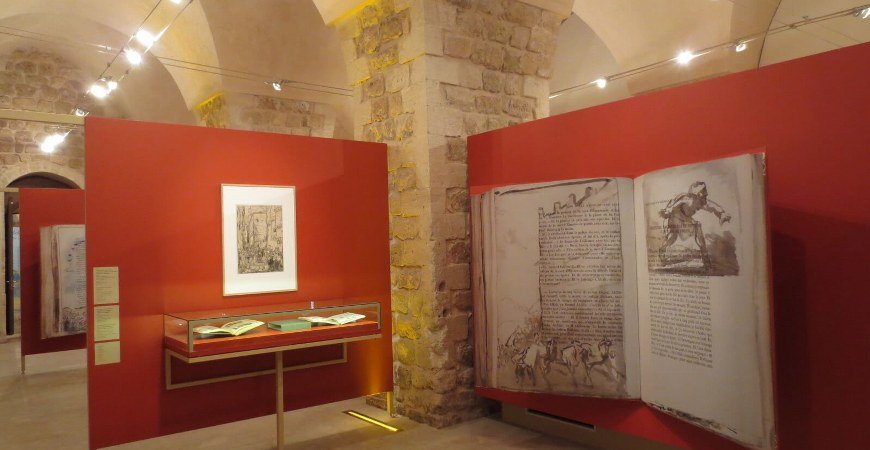
The Museums of Mugla – Manisa Museum and Mardin Museum
The Museums of Mugla – Manisa Museum and Mardin Museum,
THE MUSEUMS OF MUGLA
Fethiye Museum:
Fethiye Museum was established in a temporary building in 1965 and consists of two rooms. The first exhibition room contains pieces of a tomb from Tlos, grave steles, offering stones, column pedestals and capitals, and earthenware vases and statuettes from the Lycia, Roman, and Byzantine periods. The second room contains coins from various periods, pre-historical and historical ornaments, statues, busts etc.
Milas Museum:
In 1959 works from the Mugla sub-province of Milas were stored in a room and the garden of Sakarya primary school. A new museum building is being constructed which will house the Milas Museum upon completion.
MARDIN MUSEUM
Mardin Museum was established as a depot in a section Sinciriye Mosque in 1945. When this grew too small the collection, which includes Islamic and pre-Islamic works, coins etc., was moved to the depots of the Ministry of Education. Among the unique objects in this collection is a double dragon-headed door knocker from the Seljuk period, which was taken from the Cizre Ulucami.
MANISA MUSEUM
Manisa Museum was first established as a depot in Muradiye Kulliye Medrese in 1935, and archaeological and ethnographic works from the Manisa region were stored here.
In 1943 the museum was opened to the public. It was closed from 1958 to 1962 for repairs to the Medrese, and in 19163 was enlarged with the inclusion of the Imaret (soup kitchen), which Was opened to the public in 1972. Today the Imaret contains the archaeological works, while the Medrese contains the ethnographic works.
The corridors of the archaeological section contain sculpture from Manisa arranged in archaeological order. The first rooms contain Byzantine period works, and the other rooms Roman period works. The large exhibition rooms contain the findings of the excavations at the ruins of Sart which began in 1958. They are arranged according to period and include mosaics, ceramics, various stone objects, terracotta and bone ornaments etc.
The last rooms contain findings from the Roman period and a rich collection of findings from the Prehistoric ages.
The second section of Manisa Museum is housed in the Medrese and contains examples of Turkish art and ethnography. One room has been furnished as a room in a Turkish house. Exhibits in this section include weapons, cloth wood carving, engravings, tiles, embroidery, carpets, and kilims which make up a really fine collection.

Bodrum Museum Turkey
The Museum of Bodrum,
Bodrum Museum is housed in Bodrum Castle and was opened to the public in 1964. Bodrum Castle was built in the XV century by the St. Jean Chevaliers who came here from Rhodes, in the name of St. Peter of Navarro. Stones from the famous Mausoleum of old Halicarnassus were used in the construction of the castle and remains of it can still be seen. On the walls of the castle can be seen the coats of arms of the chevaliers, inscriptions, and bas-reliefs of saints. The Castle has four towers known as the Italian, French, German and English towers. During the Ottoman period the castle was used as a prison, and during the First World War, many parts of it were destroyed. Repairs were begun in 1962, and some sections of it made into a museum.
1 — Mycenean room: This room was originally the church of the castle, and contains earthenware vases, dishes, ornaments etc. from the Mycenean civilization (1500-1000 BC). Most of these were found by excavations at Musgebi. Also exhibited here are statues from the Archaic period (VI century BC), a statue of Demeter, Hellenistic period earthen-ware sarcophagi and water jars, and a bas-relief from the Mausoleum depicting Amazons at war.
2 — Underwater finds: This room has three sections. The first contains works dating from the VI century to the I century BC which was found by sponge divers. Among these works, which came from wrecked ships, the most interesting is a bronze bust of a negro child and a bronze statue of the Egyptian god Isis.
The second section contains the findings of underwater exploration carried out by Pennsylvania University on the Phoenicia – Gelidonia costs. Among the finds are objects from a Phoenician ship which is considered to be the world’s oldest wreck. They include bronze tablets which were used as money and agricultural equipment. The third section contains underwater findings from the Yassiada coast near Bodrum. These include objects from a Byzantine ship which is thought to have been wrecked in the first half of the bill century, such as amphoras, a ship’s steelyard, coins, and various ship’s equipment. The pent house of the room contains various jars and anchor stocks made of pierced stone.
3 — Karya room: This room contains works found in the Karya region. They include works from the Bronze, Archaic, Classical and Hellenistic periods, silver coins from Karya, ornaments, and seals. A separate section contains photographs of bas-reliefs from the Mausoleum, engravings and a picture of Herodotus from Halicarnassus.
The castle also contains various styles, inscriptions, canon balls, primitive stone anchors, water jars etc.
The museum has a rich depot, workshops, a library, offices etc.
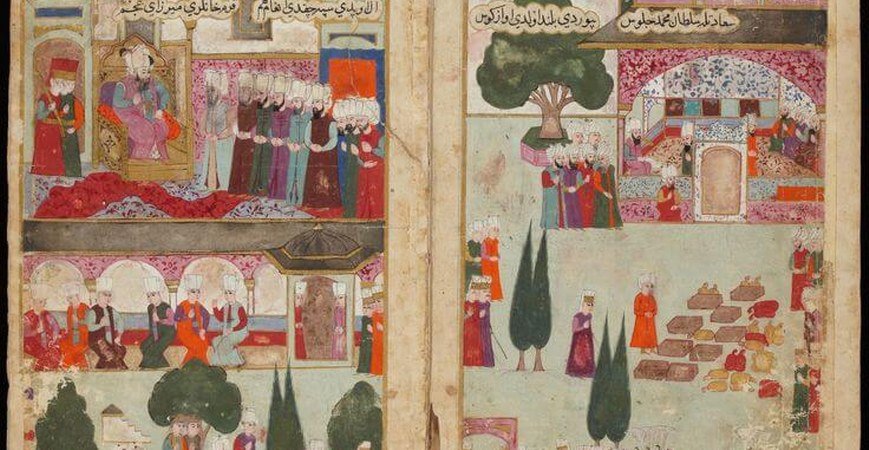
Manuscripts Treasury Istanbul Turkey
Manuscripts Treasury Istanbul Turkey,
According to estimates, there are five hundred thousand manuscript books, most of them single editions, in Turkey’s libraries and museums. I do not think that any other country can boast of such an inheritance of manuscripts recording its own culture from the past. None of the world’s well-known libraries have a collection of manuscripts surpassing a hundred thousand, and even those that there are gathered from many countries, whereas Turkey has nearly half a million manuscript books which are all the work of her own artists. An unimaginable treasury of manuscripts, nearly all of which aro decorated with gold, and the writing, bindings, and miniatures of each book a masterpiece in itself. Not one resembles any of the others, each is a unique work of art. We are a nation of book lovers. In the past large libraries were opened for the benefit of the people. There the works of scholars, writers and poets were read and studied. These books were not only considered to be decoration but to be read and taught to others. Masters of several branches of art developed separately over the years, contributed to the making of one book: The calligraphers wrote it, the gliders decorated it with colored paints, and the bookbinders bound it. However, we have not made the good use of this treasury that it deserves. Instead of sitting down and studying them, we preferred to exhibit the books in museums and preserve them in libraries. Whereas the Europeans have translated many of our manuscripts works into their own language and published them, in many instances together with the original text. In recent years we too have taken a step forward. A program aimed at translating into modern Turkish basic works of Turkish culture or those written in the old Arabic script to present to the new generations has been started. The most extensive collections of manuscript books are in Topkapi Palace, the Museum of Turkish and Islamic Art, the Suleymaniye and Beyazit State Libraries and Konya Mevlana Museum. The books in the Treasury, Ahmed the Third, Agalar Camii, Emanet, Baghdad, Revan Kosku and Sultan Resat Libraries are of great value for their calligraphy, bindings and gilding. Among these works are the Sehname, Hunername, Hamse-i Nizami, Fatih Album, Suleymanname, Semailname-i Ali Osman, Surname, Humayunname and many others, which are illustrated by such famous masters of Turkish miniature painting as Mehmed Siya’h Kalem, Nakkas Osman, Nigari, Naksi, Levni and Kalender. The books and albums in Topkapi Palace contain a total of 3,533 miniatures. It is like finding oneself in a paradise of books with their beautiful leather and lacquered bindings. It is impossible to decide whether to read them or caress them or look, ai them.
It is not enough to feel proud of these books, we should appreciate their value and make good use of these treasures.
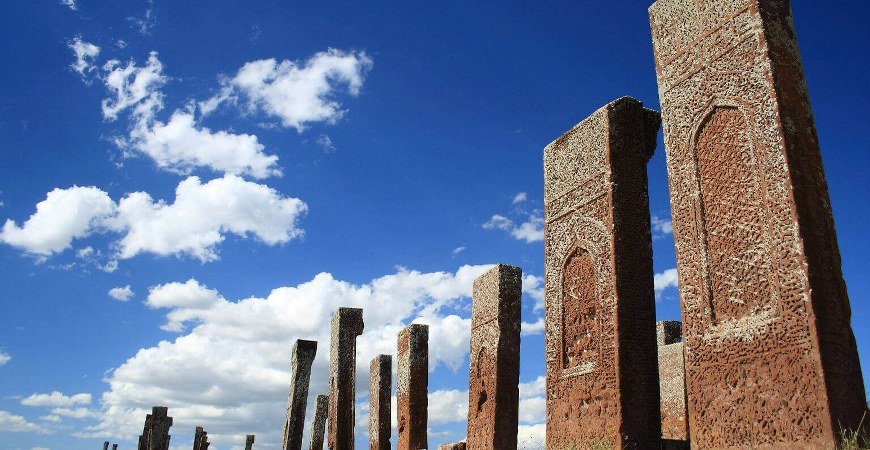
The Masterpieces Of Ahlat in Bitlis Turkey – Chapter 1
The Masterpieces Of Ahlat in Bitlis Turkey – Chapter 1,
Close to the northwest shores of Lake Van in Eastern Anatolia is the lovely sub-province of Ahlat. The city of Ahlat used to be a thriving, renowned city of a hundred thousand inhabitants, called Kubbet-al-Islam (Dome of Islam) during the Seljuk period. Ahlat was one of the first cities founded by the Seljuk Turks in Eastern Anatolia after the Malazgirt War of 1071. After the arrival of the Seljuks the small Anatolian provincial town of Ahlat grew and spread until it hugged the green shores of Lake Van. Many scholars and artists came to Ahlat and settled in the city. The master stone masons of Ahlat worked the stone as if it were clay, skilfully cutting and shaping it, making domes, arches, and doorways carved like lace. The craftsmen of Ahlat not only decorated the buildings of Ahlat, but became famous for their work in the cities of Konya, Kayseri, Sivas, Tokat as well. Ahlat created the works of art of an entire age. Among the architectural works which remain in Ahlat today are tombs and mescids. The tombs were arranged in rows and built in the shape of a Turkish tent. Each one was a monument in itself, the entire surface is covered with Seljuk motifs. It is the gravestones of Ahlat which are really worth seeing. Do not just dismiss them as mere gravestones, each one is a masterpiece. Turkey’s old graveyards are like open air museums, and that to the west of Ahlat called “Meydanlik” contains the finest and most interesting examples of the immortal art of Turkish stonemasonry. You can hardly call it a graveyard, it is more than that. The graves are built one over the other, consisting of domed and arched grave rooms and carved gravestones over two meters in height. This is why the people do not call it the “Graveyard” but the “Meydanlik” (Square). It is as if an art competition had been organized in the city, and every craftsman painstakingly created works to show off his greatest skills.
You can continue to find more details about The Masterpieces Of Ahlat in Bitlis Turkey in Chapter 2.
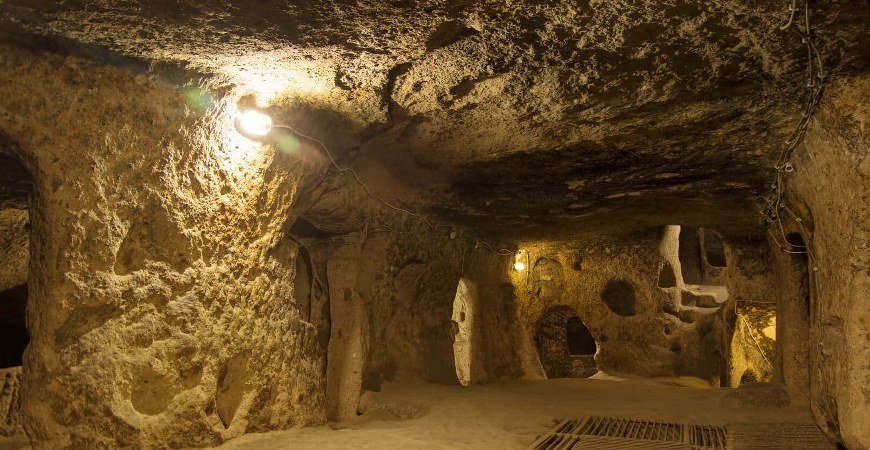
Kaymakli (Enegup-Enegobi) and Underground City of Cappadocia
Kaymakli (Enegup-Enegobi) and Underground City of Cappadocia,
This town is established on the asphalt road of Nigde and Nevsehir and it is 20 km away from Nevsehir and 9 km from Derinkuyu. The foundation date of this town is not known. Its old name was EnegOp but it was changed into Enegobi by the Greeks that lived there before and into Kaymakli by the Turks. Enegup (Kaymakli), Melegop (Derinkuyu) and Gople are old neighbor settlement centers established on the same road. The underground city dug under a hill in the middle of the town called Kaymakli Today, was found in the year 1964 and opened to tourism. This city has four layers that can be visited. The number of layers it has altogether and the places that hove not been brought to light lighted have not been determined so far. This city can be visited for approximately 15-20 meters. This city, as the other cities which also accepted Christianity, was dug by tribes escaping from oppression and the fear of disappearing and was used both as shelter and against enemies and as a secure place for worship. Although the city looks as if it is made on a complicated plan, it is obvious that great attention and skill was used in the excavation of this city. Although the tunnels and rooms are very complicated, an excavated room did not join another excavated room. Places visited are bedrooms, food warehouses, wine cellars, ventilation chimneys, water depots, the church with double passes to worship and stone doors to get protected from all kinds of danger that can come from outside. These stone doors were placed in the tunnels just as the other underground cities and the can only be opened and closed from inner parts. There are graves having a simple structure on the rocks just on top of the underground city and all of these are in a clean position.

The Masterpieces Of Ahlat in Bitlis Turkey – Chapter 2
The Masterpieces Of Ahlat in Bitlis Turkey – Chapter 2,
These hundreds and thousands of gravestones in rows are each a monument representing Turkish decoration and tastes, dating from the thirteenth and fourteenth centuries. Besides the traditional Seljuk motifs which decorate the gravestones of Ahlat the writing inscribed upon them is of value in itself. Every stone throws light on the history of the period. From them, historians have learned the names of long forgotten artists, famous commanders and scholars. It is said that in several regions of Anatolia the Seljuks would only use Ahlat craftsmen in the construction of buildings. And these craftsmen did not only work stone but also wood, bronze, and iron with equal skill. That became a kind of academy of fine arts, training craftsmen and sending them to the four corners of the nation. The city became the center for those who felt the exuberance of art in their hearts, for the greatest artists. The Great Graveyard in Ahlat is at present being organized as an Open Air Museum. Archaeologists are uncovering the hundreds of graves which lie underground and repairing the underground grave rooms. After studies here are completed it will become one of Turkey’s most interesting museums. It is to be called Ahlat Graveyard Open Air Museum, containing hundreds of masterpieces, every one of them a monument to the supreme skill of a sculptor. In the words of one art historian: “These gravestones speak for a nation which expressed its vast joy of art in stone, which spoke through stone, which built monuments to the artist. If you call these gravestones at all.”
This is really so. If your road ever takes you to the north west shore of Lake Van do not pass without seeing Ahlat. You will see a vast collection of masterpieces at Ahlat Open Air Museum, which astonishes those who see it.
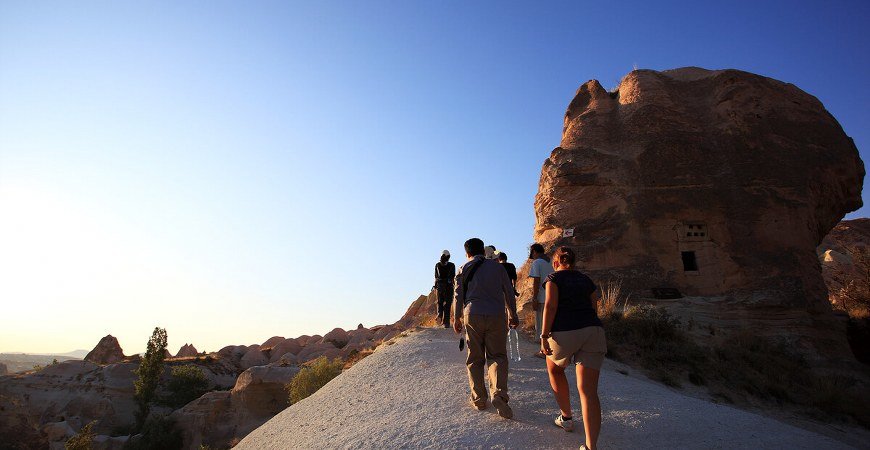
Mazi (Mataza) Village in Derinkuyu Cappadocia
Mazi (Mataza) Village in Derinkuyu Cappadocia,
Mazi (Mataza) Village:
One of the places that are not in opened to tourism and that is not in enlighted in the Cappadocia region is the Mazi Village. If you go 7-8 km east from Kaymakli, you will come to a village established within a stream. The interesting places in this village are old graves carved into high rocks, chapels, and churches of different structure and the underground city.
These graves were made in three different forms. Four of these have columns and are very interesting. Some have no columns and the inner parts in which the deceased were put are the same. There are about thirty graves altogether with and without pillars. The other graves on the plain over the rocks reach thousands in number. Although there were many churches and chapels on the rocks over the village and at the region of B4irsak Stream, some of these were demolished and filled with earth. But a church carved in the rocks at the south of the village still remains clean and solid. This church has a pillar in the center, a big apsis on the left part at the entrance and two ceilings in the shape of an arch. A big cross can be seen on each side of the apsis. There is a similar cross on the front side of the pillar in the center. In the wide part looking North, there is a design of small crosses attached to each other.
The underground city in the village can be entered through a hollow in a rock going from east to west. The real entrance door has not been found because high rocks fell from their places and the real entrance door disappeared. Although the fallen rocks opened new entrances these entrances are very high. It is very difficult to determine the layers of the underground city which is still very difficult to visit because some of its parts were demolished and some were filled with earth. Mazi Village of Derinkuyu is one of our historical places that should be opened to tourism and enlightened Unfortunately in its present state, it is just like a ruin.
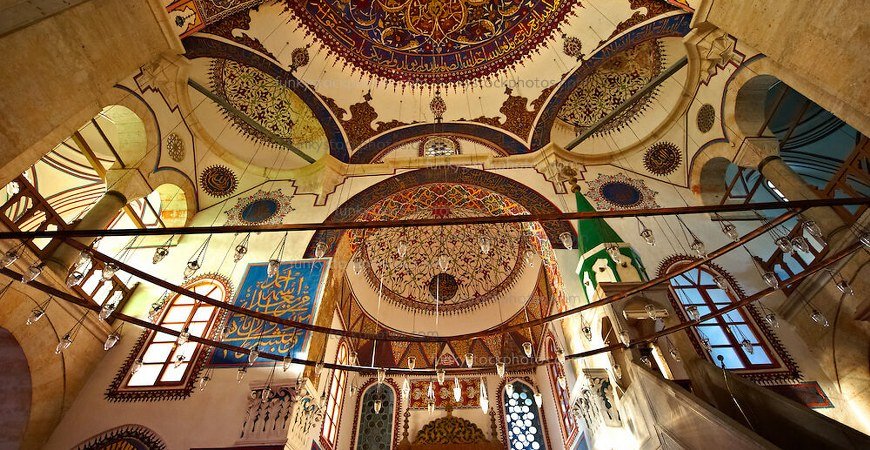
The April Cup in Mevlana Museum Konya Turkey – Chapter 2
The April Cup in Mevlana Museum Konya Turkey – Chapter 2,
May this cup bring him happiness and good fortune.” According to these inscriptions, the April Cup was made for the last Ilhan Sultan Abu Said Bahadir Han who ruled in Baghdad from 1317 to 1335. Abu Said Bahadir Han was the son of the Ilhan sultan Olcaytu Mehmed, who died in 1317. Abu Said Bahadir Han came to the throne in Tabriz at the age of 12 years old, and while he was still young the affairs of state were managed by the vizier Emir Coban. After managing the state successfully for ten years he was killed on the orders of Abu Said Bahadir Han, who then married the vizier’s daughter Baghdad Hatun. Her heart burning with revenge Baghdad Hatun managed to get the affairs of the state entirely into her own hands. When Abu Said Bahadir Han married her niece Dilsat Hatun her veins swelled with jealousy and in the month of November 1335, she killed the sultan by poisoning him. Left without a leader the army commanders killed Baghdad Hatun. So the April Cup is not only a magnificent work of art but also a souvenir from a period full of palace feuds. It is the painstaking work of years of a Turkish craftsman, who made it for the sultan. Historians have investigated how the cup happened to find its way to Konya and found the answer. In the library of Mevlana Museum is a single leather bound edition of a manuscript book of poetry. On the 486th page of this book is ‘written the following “It is a gift to the Great Sultan Abu Said ‘Bahadir Han who brought happiness to his people, justice to his lands, was the ruler of nations. This cup was made in 728 Hicri (the year 1327) in Mosul. In 734 (the year 1333) the cup was put in the hands of the Emir Sungur Aga with a plea for intercession, and sent to the holy and innocent Tomb of Mevlana”. According to this important document our masterpiece, the April Cup, was made in 1327 and sent to the Tomb of Mevlana by Abu Said Bahadir Han in the charge of Emir Sungur Aga. Emir Sungur Aga who brought the April Cup to Konya and presented it to the Tomb of Mevlana was one of the seven emirs which were sent to Anatolia by the Mongol-Ilhan sultan Abaka Han. Emir Sungur governed Nigde and the surrounding region for many years and had a mosque built there in his name. When Emir Sungur died he was buried in the Tomb adjoining the mosque which he had built in Nigde. I have tried to briefly describe the history of this unique work of art, the April Cup. In 1936 the April Cup was sent to America for exhibit in the Exhibition of Masterpieces of Turkish Art. It took pride of place and attracted great interest.
Today the April Cup is exhibited in the most prominent position in Konya Mevlana Museum. It is situated at the head of the sarcophagi of the Khorasan Soldiers, the place ‘where it ‘was originally placed 644 years ago. The museum authorities make sure that it is never moved anywhere else. Konya Museums are justified in feeling pride in this masterpiece. the April Cup, executed with such craftsmanship with gold and silver damascene that it has dazzled the eye for centuries.

The April Cup in Mevlana Museum Konya Turkey – Chapter 1
The April Cup in Mevlana Museum Konya Turkey – Chapter 1,
Among the masterpieces in the Mevlana Museum is a footed bowl 65 cm. high and 95 cm. wide made of bronze and decorated with inlaid patterns of gold and silver called the April Cup. On the cover is a figurine of a large cock. It is so large and heavy that one person can only carry in with difficulty, and it is made of four parts, and decorated over its entire surface with miniature writing and motifs. At first glance, it resembles a large soup bowl. To answer the questions of when and for whom it was made one has to look at rumors and documents. April rain has traditionally been considered lucky and holy. The custom of collecting the rain which falls in April in basins and bowls and then scattering it on the crops to bring about a good harvest still live in Anatolia. It is said that the April cup, which has been in Mevlana’s tomb for 650 years, was used to collect the April rains. Then after being left in Mevlana’s Tomb for a few days, it would be distributed to visitors and sick persons as the water of abundance and health. For this reason, it was named the April Cup. Under the feet of the figure of the cock are several birds and on the lid are plant and geometric motifs among which are figures of birds and animals, all damascened in gold and silver. The lid is also decorated with a row of medallions and a line of writing. On the medallions are the figures of people sitting cross-legged. The body of the cup is similarly decorated, except for the designs on the medallions, which include horsemen holding a falcon, rulers seated on their thrones, and sakis holding drinking cups and serving the sultan. The writing includes a poem, the rest being praise of the Sultan.
One of these is a follows: “Exalted padishah, high ruler, leader of nations, the just and wise sultan of sultans Ebu Said Bahadir Han.
You can continue to find more details about The April Cup in Mevlana Museum Konya Turkey in Chapter 2.
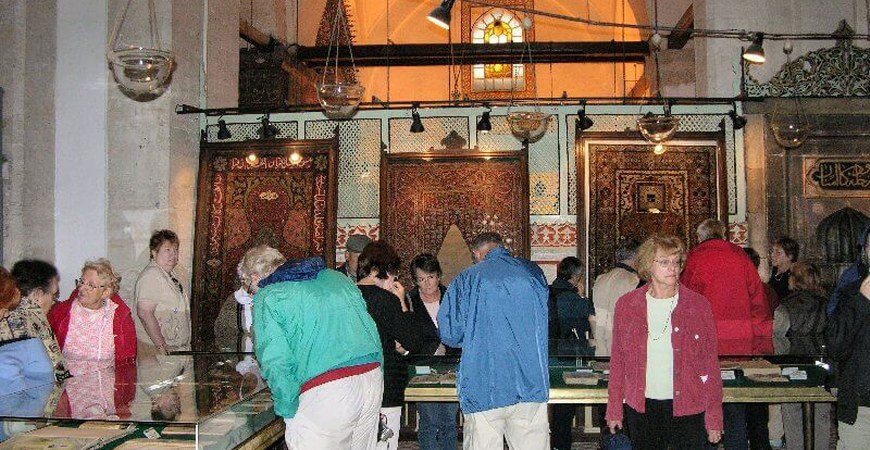
Mevlana’s Prayer Carpet Konya
Mevlana’s Prayer Carpet Konya,
Those who visit the Mevlana Museum in Konya where many masterpieces of Turkish craftsmanship are exhibited gaze in wonder at a prayer carpet which resembles a flower garden displayed on the wall in the Mescid. Although the museum contains several four hundred and five hundred-year-old Anatolian prayer carpets, it is this one which draws the most interest. The plaque underneath reads: “This prayer carpet was sent to Mevlana as a wedding present by the Seljuk Sultan Alaeddin Keykubad I.” This single sentence attracts great interest and increases the value of the prayer carpet. According to written sources, Mevlana Celaleddin emigrated from Belh to Anatolia settling in Karaman (Larende), where he married Gevher Hatun, the daughter of Serefeddin Lala a disciple of his father Bahaeddin Veled. The year was 1225 and Sultan Alaeddin Keykubad I was on the throne. We do not know ‘whether Sultan Alaeddin Keykubad sent a wedding present to Mevlana or not, only that upon the Sultan’s invitation Mevlana moved to Konya from Karaman where he had lived with his father and family for 7 years. The prayer carpet, supposedly a wedding present to Mevlana, is medium sized and made of ‘wool. The upper border and half the sides have a verse from the Koran in Sulus writing, and the part where you touch your forehead has written: “Allahu Akbar” (Almighty God). The rest of the border is decorated with rumi motifs and flowers in red, yellow and dark blue. For years the carpet was kept in a box in the Mevlana Dargah with Mevlana’s clothes and looked after with care although it has worn in the places where it has been folded. In 1926 when the possessions of the Dergah were handed over to the museum in the presence of a delegation of experts, and each item recorded, this carpet was listed in the inventory as The wedding present of Sultan Alaeddin Kaykubad to Mevlana”. Was this really a Seljuk period work, or had it been ‘woven at a later date, brought to the Mevlana Dergah and claimed to be Mevlana’s? One is al-ways faced with this question. Many of the objects in the museums of the world are said to be the possessions of great men. It is normal. But although most of them are truly what is claimed there are others of which no one can be sure. It is hard to rely entirely on rumor when there is no documentation to back it up. However, this prayer carpet whether it is really Mevlana’s or not still deserves a prominent place in the museum as a masterpiece of art. It is a traditional Turkish palace carpet whose colors and designs reflect those of the XVII century, such a beautiful prayer carpet. The fact that it is said to belong to such a great man as the immortal Mevlana enhances it with a spiritual value.